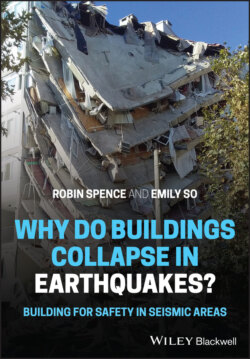Читать книгу Why do buildings collapse in earthquakes? Building for safety in seismic areas - Robin Spence - Страница 22
2.2.6 The 12.5.2008 Wenchuan Earthquake: Mw7.9, 87 476 Deaths
ОглавлениеThe Mw7.9 Wenchuan earthquake occurred at 14.28 local time on 12 May 2008, with its epicentre in Wenchuan county in Sichuan Province of China, at a depth of 19 km. It caused a fault rupture of around 240 km along faults which form the boundary between the Longman Shen mountains to the north‐east and the Sichuan basin to the south‐west. This is a densely populated region, and the earthquake was devastating to a large area, affecting more than 250 000 km2 and 30 million people (EERI 2008). Peak ground acceleration exceeding 0.5 g was felt over a wide area. The earthquake resulted in approximately 87 500 deaths (including 17 920 missing people), and 375 000 injuries, and required almost 1.5 million people to be relocated. It was the most lethal earthquake to strike China since the Mw7.5 Tangshan earthquake in 1976 which killed an estimated 242 000 people.
Although most of the deaths were caused by the collapse of buildings, a notable feature of this earthquake was the very large number of slope failures, causing landslides, rock‐falls and mudflows. By one estimate there were more than 15 000 such failures, which resulted in around 20 000 deaths, or nearly 30% of the total (Yin et al. 2009).
Most of the buildings affected by the earthquake were masonry buildings. In the rural and mountainous areas, these were traditional unreinforced masonry (URM) buildings of brick or stone with timber floor and roof structures, which were highly vulnerable to earthquake ground shaking. In the urban areas also many URM buildings existed, often of several storeys, with precast concrete hollow‐core floors and roofs, and this included many school buildings (Figure 2.12). In the urban areas, one common form of building had a RC ground floor with URM above, while others were of confined masonry construction (EERI 2008). The urban URM buildings did not perform well in the earthquake and there were many partial or catastrophic collapses.
Many of the mixed RC and brick constructions too were seriously damaged, including many ground floor ‘soft‐storey’ collapses. There were some recently constructed RC frame buildings in the larger towns and these were reported to have performed relatively well, and to have resisted collapse in spite of the fact that the ground shaking was much more severe than the levels required by the design codes over most of the area (EEFIT 2008b).
Particularly noteworthy was the tragic collapse of many school buildings. It has been estimated that more than 7000 school classrooms collapsed in the earthquake, and, as children were in school at the time of the earthquake (14.28 local time), that possibly more than 10 000 children died as a result. Often, collapsed school structures were sited next to other relatively undamaged buildings. This led to angry protests by bereaved families, whose only child was often the victim. Protesters blamed both shoddy construction and the government which should have supervised such construction more effectively. Official investigations took place and are said to have identified many design defects, and there have been subsequent changes to the required standards for school construction (Wong 2008).
Figure 2.12 Partially collapsed five‐storey masonry middle school building in YingXiu in the Wenchuan earthquake.
Source: EEFIT. Reproduced with permission.
